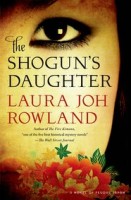 Author: Laura Joh Rowland
Author: Laura Joh Rowland
Publisher: St. Martin’s Press
ISBN: 9781250028617
Released: September 2013
The Shogun’s Daughter is the seventeenth volume in Laura Joh Rowland’s mystery series set in Tokugawa-era Japan and featuring Sano Ichirō as a main protagonist. Despite my interest in Japanese history and my enjoyment of mystery and crime fiction, somehow it wasn’t until I received The Shogun’s Daughter through LibraryThing’s Early Reviewers program that I became aware of Rowland’s Sano Ichirō novels. The series made its debut in 1994 with the novel Shinjū. Over the years, a few of the individual volumes in the series have been nominated for major genre awards for mystery and crime fiction. The Shogun’s Daughter was released in 2013 by the mystery and suspense imprint of St. Martin’s Press, Minotaur Books. (Minotaur also happens to be the publisher for Keigo Higashino’s Detective Galileo series in English, which I enjoy.) Even though I hadn’t previously read any of Rowland’s Sano Ichirō mysteries, I was still looking forward to reading The Shogun’s Daughter and giving the series a try.
In late 1703, a massive earthquake and accompanying tsunami devastated Edo, killing thousands of people. A few months later another death would also have a tremendous impact on the city. Tsuruhime, Shogun Tokugawa Tsunayoshi’s only child, dies of smallpox. However, some members of the government are convinced that her death wasn’t entirely natural. With Tsuruhime’s passing, the shogunate’s chain of succession has become even more precarious. The Shogun finally feels compelled to name his heir—Yoshisato, a young man claiming to be his long-lost son although many suspect that he’s actually the son of the official Yanagisawa Yoshiyasu. Yanagisawa is now in a position to control the shogunate through Yoshisato and it doesn’t take long for him to purge the government of those who would stand against him. Among them is Sano Ichirō, who once served as the Shogun’s right-hand man. But if Sano can prove that Yanagisawa is somehow connected to Tsuruhime’s death, he stands a chance of regaining his status and revealing Yanagisawa’s plot for power.
As Rowland has sixteen novels worth of material to cover, the beginning of The Shogun’s Daughter is understandably a little slow going. Those who have never read a Sano Ichirō mystery will be at a slight disadvantage, but the most critical points of the characters and their backstories are quickly established. It’s obvious that they all have quite a history with one another, though, particularly Yanagisawa and Sano with their ongoing rivalry. Occasionally an unclear reference is made to something that occurred earlier in the series, but generally The Shogun’s Daughter stands reasonably well on its own. The only major exception to this is the side-plot dealing with Hirata, one of Sano’s chief retainers, which feels terribly out-of-place with the rest of the novel. It contains the only supernatural elements to be found in The Shogun’s Daughter—Hirata is practitioner of the “mystical martial arts”—and has no direct impact on the main story. It seems to be a plot line carried over from the previous novels, and it leads into the next, but in The Shogun’s Daughter it mostly serves as an unwanted distraction.
It may take The Shogun’s Daughter some time to find its flow, but once it does the novel and mystery move along at a fairly rapid pace. Sano isn’t the only one who is involved with the investigation into Tsuruhime’s death—his wife, son, and even Hirata’s young daughter all help, making it something of a family affair. Their logic is a little shaky in places, but this can usually be explained by the younger characters’ inexperience, the stress of the situation as a whole, and government intrigue and political maneuverings. What I appreciated the most about The Shogun’s Daughter is how Rowland has used historical figures and events as a framework to craft her story. Sano and his family may be fictional, but many of the people they deal with, including Yanagisawa, are not. The natural disasters and recovery efforts as well as the trouble with the Tokugawa succession are all based on actual events. Unfortunately, the dialogue and some of the terminology used feels too modern and would throw me out of the setting. Otherwise, the time period is nicely established and Rowland quite cleverly weaves her characters and mystery into Japan’s history.
Thank you to St. Martin’s Press for providing a copy of The Shogun’s Daughter for review.

Speak Your Mind